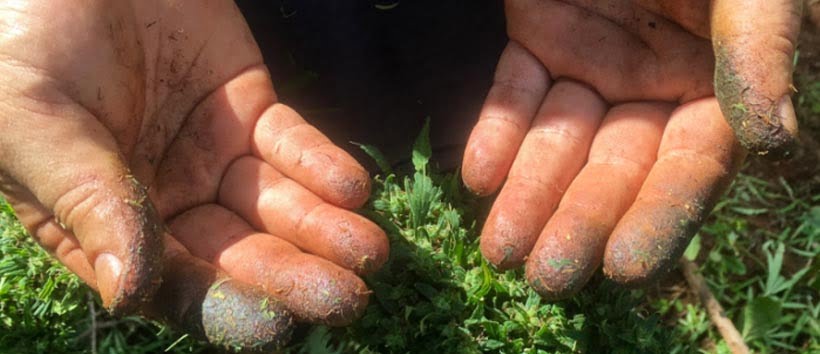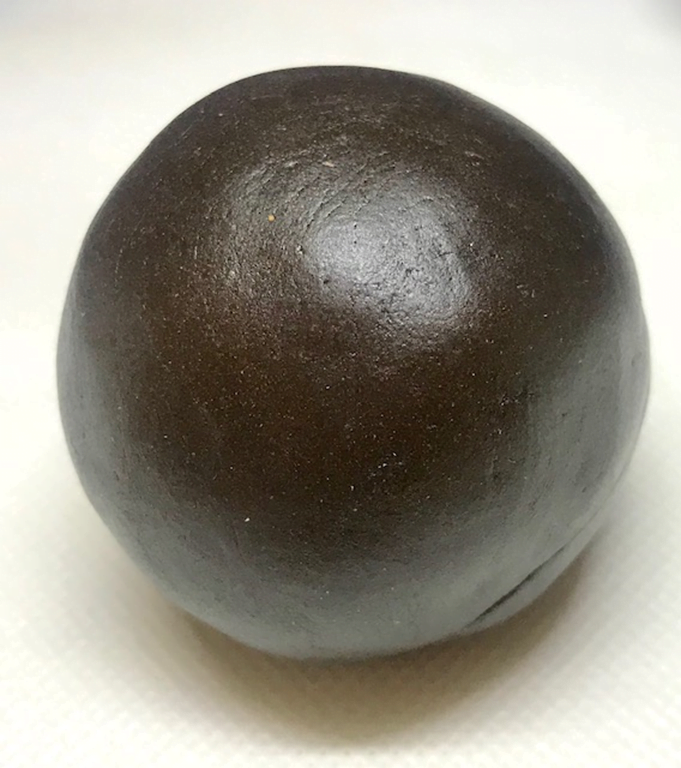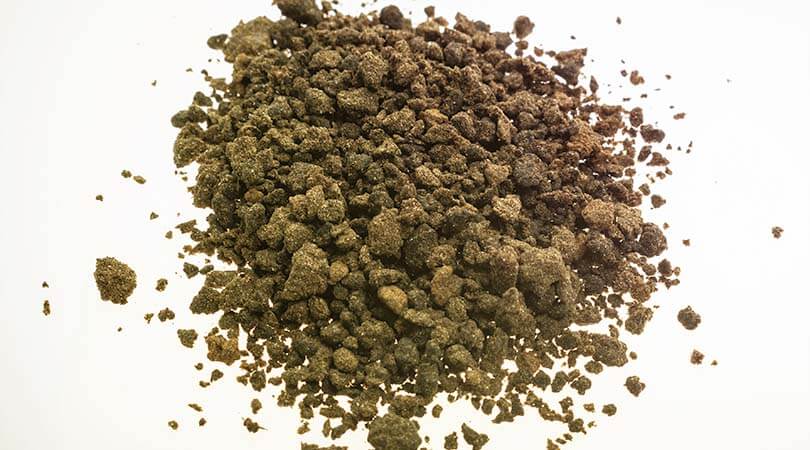English
Nowadays, you can enjoy a variety of cannabis concentrates. Cannabis Oil, Shatter, Crumble, Dough, Butane Honey Oil, Rick Simpson Oil – there are many different variations on the same theme and you probably have your own favourite cannabis concentrate. But many will remember the time when the only choice was between weed and hashish. So what is hash, how is hash made, what is the potency and how is hash different from other cannabis concentrates?
What is hashish?
Hashish is simply the waxy product created when the cannabis trichomes (resin glands) are concentrated and compacted into a solid block. In addition to the cannabinoids, hashish also contains small amounts of plant material and many terpenes, which provide the distinctive hashish flavour. Many simply smoke some in a pipe or bong. Others roll a thin “sausage” of hashish and put it in a joint to load it up. Some people crush small chunks of hash in a vaporiser, others prefer to cook with it. Hash is a potent cannabis concentrate, a small amount of which has a big effect!
Hash has been used for thousands of years, ever since the first humans noticed the strange sticky by-product of the cannabis plant. Hash can be smoked or used for cooking and usually contains between 5 and 40% THC, often with a higher CBD content than conventional weed. The final content of THC, CBD, etc. depends on the cannabis genetics, growing conditions and the processes used to produce hashish. For some cannabis lovers, hashish is a unique treat because of its aromatic smell and taste. It is easy to store, transport and enjoy.
In the 1980s, hashish was exported from some of the main growing areas (Nepal, India, Pakistan, Afghanistan) with a unique seal on the hashish block, and it was often wrapped in red or gold packaging before export. It is easy to grow cannabis at home, so you can make your own hashish at home if you wish. Traditional hashish imports from countries like Afghanistan, Nepal and Morocco can still be found, often at cheap prices. You can also find these traditional hashish imports in the Netherlands and other countries.
Learn how to make hashish easily at home
Simple homemade hashish from leaves and scraps
The trichome resin glands form on the leaves, buds and branches of the cannabis plant. Normally, the buds are harvested and the rest is thrown away. Most people just don’t feel like making hash out of the leaves and scraps left over after the harvest. After all, they already have plenty of top quality bud. But with a little effort, this waste can be used to make hashish. And it’s amazing how much hash you can make from plant waste. Some growers also process their buds into hashish.
Finger hash: The original form of the hash
The oldest and probably most original method of making hashish is to scrape the sticky cannabis resin off your hands when handling cannabis buds or harvesting your home-grown plants. Hash can be made simply by rubbing the cannabis flowers with your fingers. It’s a bit messy, but scraping your fingers will give you a ball of potent “finger hash”. The friction and heat transfers the sticky cannabis resin from the plant to your skin. From there, it’s just a short journey to your vape, pipe or joint.

Scissor hash: make scissor hash easily at home
Anyone who has harvested their own cannabis plants will be familiar with the scissor hash that quickly builds up on the scissors used to cut the plants and buds. Sometimes, especially with a well-grown premium cannabis seed strain, you may need to occasionally scrape the hash build-up off your scissors or trimmer. Scissor hash is excellent hash, with all the terpenes from the fresh plant you get a great taste treat.
How to make rosin hash with hair leaves
Hashish is very easy to make at home with a normal hair straightener. Just take a bud and place it in a folded sheet of greaseproof paper or parchment paper. Heat the hair straightener and then crush the bud in the paper. The heat will change the sticky resin into a more flowable liquid, which will be squeezed out of the bud under the pressure of the straightener. Press hard for one minute! Then you can take the crushed bud out of the paper and scrape all the pressed rosin out of the bud.
When it has cooled, you can see the amber residue, commonly known as rosin or rosin hash. Using this technique, you can quickly and easily make rosin hash from your buds. The only disadvantage of this technique is that it takes a very long time to make large quantities of rosin. One of the advantages of rosin is that it is a clear and pure extract that looks similar to shatter. It is also a completely solvent-free method of making a cannabis concentrate.
How to make rosin hash with a rosin press
Making your own rosin has become a very popular way to make cannabis concentrates at home. No solvents are used, it is safe and there are none of the explosion risks associated with making butane-honey oil (BHO), for example.Large-scale rosin hash producers have taken advantage of the professional rosin presses that are now available. These are industrial quality devices that apply tremendous pressure to the buds, sometimes using heat on the pressure plates. Rosin presses come in all sizes and for every budget. Prices range from about €100 for a small device for private use to several thousand euros for a high-end, large-volume device.
Instead of pressing the rosin from a single bud, the professional presses can exert several tons of pressure on a large bag of buds thanks to the hydraulic mechanism. In this way, an ounce (28 g) or more of buds can be pressed in each operation. Special squash mesh bags are used for the professional rosin presses. These have been developed to maximise the yield of rosin from the buds and to achieve maximum efficiency. As pressing rosin only takes between 1 and 5 minutes (depending on the temperature and quality of the buds), a single professional press can be very productive if used continuously.
How to roll hashish by hand
Hand rolling is a technique of rolling the flowers firmly between the palms of the hands to collect the hash, often during harvest. Unlike finger hash or scissor hash (which is often an unintended bonus after harvest), hand rolling is a process of consciously converting the flowers into hashish. It may not be the most efficient process, but then again, hand-rolled hash has probably been used for thousands of years, when cannabis was still grown in large quantities and without prohibition.
Hand-rolling hash probably originated when Stone Age man found fields of cannabis plants and wanted a quick way to make hash from them. With such a surplus of buds, the low efficiency of hashish production did not seem to be a problem. Hand-rolled hashish is simply scraped off the hands, along with sweat and dirt, and pressed into a shiny ball. Old school simplicity with great modern appeal!
What is Charas?
Charas is another name for handmade hashish. The Charas makers rolled fresh cannabis flowers between their palms. The hashish is then scraped off and collected. Some of the most valuable Charas products are the light Malana Cream products, which take hours of work to make for just a few grams. Unlike hand-rolled cannabis (which can be made from dried and cured flowers), charas is usually made from fresh (occasionally immature) and uncured buds/flowers.
What is Nepalese Temple Ball hashish?
These were palm-sized hash balls, sometimes egg shaped. They were made in Nepal and were hugely popular in the 1960’s and 70’s as hash popularity boomed. The cannabis was grown outdoors in the Nepali mountains and converted into hash balls by hand. The genetics that grew in the rugged mountain regions were typically indica dominant. Often the Temple Balls had a highly polished exterior thanks to the loving hand smoothing process. The high quality Nepalese Temple Balls produced a luxurious high and were highly prized by those that could get genuine ones.
How to make hash from kief
You will probably have noticed kief accumulating at the bottom of your jars or grinder. Kief is simply the trichome resin glands that have fallen off the buds. It looks like a light brown or pale dust. This dust can be made into hash by collecting it and crushing it with your fingers. The heat from the fingers helps to melt the oils and speeds up the process. Some people invest in small hashish presses, also called pollen presses. With these, the kief is mechanically pressed under pressure into a hash block, perhaps with your own motif or logo on it. Of course, you can take the production of hash from kief even further by deliberately sifting the buds dry to create kief. Or you can use a mechanical drum to make kief.
How to make hash by dry sieving with a sieve
Some people deliberately “shake” as much kief out of their buds as possible to make hashish. It often helps if the buds have been in the freezer for a few hours beforehand. The freezing temperatures make the trichome resin glands very brittle and perfect for the subsequent shaking. The buds are then shaken on the sieve and the kief slowly falls through the sieve onto a clean, flat surface below. Sometimes the sieve is attached to the bottom of a box so that you can easily shake the box while the kief falls through the sieve. The kief can then be scraped off and collected. Of course, hashish can also be made from the remains of one’s own plants or from the best buds.
When using plant remains, one should achieve a kief content of about 10 % (by weight). When using buds to make hashish, the buds are usually broken open before shaking to maximise the yield. This makes it easy to remove the trichome glands inside the bud.
Production of hashish with a mechanical drum
To further automate the process of shaking the kief out of the buds/residues, some people use a mechanical drum device. This is usually a drum, similar to the inner drum of a washing machine, which is rotated with frozen buds/residues inside. The mechanical action of tumbling the plant material loosens the resin glands that fall from the drum. These can be sieved through a screen to remove larger particles (e.g. green plant/leaf material).
The production of hashish with a drum is usually only done by the larger hashish producers. Some less scrupulous hashish producers shake the kief out of their buds to make hashish before selling the buds. This is a risky business for the shady characters involved. Often, once the kief is removed, the buds are of much lower potency and are difficult to sell, giving the producer a bad reputation.
How to make hash with the ice/water method (bubble hash)
Hash can also be made using the water-ice method. A bucket of ice water is stirred vigorously while the cannabis is added. Buds or cuttings can be used to make hash. High quality chopped buds will produce more hash than lower quality cuttings. Due to the cold temperatures caused by the ice, the trichomes become brittle and break off easily. The stirring motion causes the resin glands to fall from the cannabis into the water.
The water is passed through a fine mesh filter (‘bubble bags’) which catches the resin glands before air drying. Choose a THC-rich photoperiod or auto-cannabis strain for best results. Making “bubble hash”, as it is also called, requires some preparation and time. It is sometimes called “bubble hash” because the trichomes can settle in the bags and form temporary wet “bubbles” as they collect.
Making hash with ice water is a solvent-free process that produces hash of excellent quality. If you want to make hashish at home in relatively large quantities, the ice water method is worth considering.
Hashish production at home with dry ice
Another way to make hashish is to use dry ice. Dry ice is solidified carbon dioxide (CO2). You can buy it online and have it delivered overnight, or you can order it from pharmacies. Dry ice uses very low temperatures, and fans claim that this preserves much of the terpene content, which enhances the flavour. The dry ice method involves mechanically shaking the buds or trim with dry ice to remove the resin glands. These can be collected in the usual way and sieved with sieve cloths or hash bags (bubble bags). The trichomes fall through the holes in the bags depending on their size.
As there are no solvents, this is a fireproof method of making hashish, but care must be taken when handling solid dry ice.
How to make hashish from male cannabis plants
Male cannabis plants are often discarded by home growers. They will pollinate the female plants and turn the buds into seeds. Most of the cannabis seeds sold today are feminised seeds. They usually grow into a crop of more than 95% female plants. But male cannabis plants also produce THC, just not as abundantly as female plants. Save the male plants for your hashish production and use them for a good cause.
Making hashish at home from hermaphrodite cannabis plants
Hermaphrodite or “hermie” cannabis plants are plants that show signs of both the male and female sex. They are often female plants that occasionally produce male flowers. Some growers “pinch out” the male flowers and monitor the plant carefully. If the hermaphrodite plant produces too many male flowers, it is usually discarded. However, you can keep the plant material for hashish production. Older hermaphrodite plants usually have more resin glands than younger plants.
What is the best method to produce hashish at home?
The hair straightener method is probably the easiest way to make rosin hash at home. But it is not a good option if you need to make larger quantities. Perhaps a rosin press would be better. Some people prefer the traditional ice-water method of hash making. A lot depends on your personal situation, how much hashish you want to make and how much money you have available for equipment.
Hashish potency, hashish with high THC content
One of the disadvantages of hashish is that it often contains small amounts of plant material. This can give the hashish a brown appearance. This limits the potency of the hashish. This has led some people to look for alternative methods of producing THC-rich cannabis concentrates. Today, there are many options, and the result is that concentrates with about 50-80% THC can be routinely produced. This is two to four times stronger than traditional hashish. However, fans of traditional hash will claim that the original hash flavour is far superior and richer to modern concentrates like Shatter.
Modern methods of making cannabis concentrates usually involve crushing the cannabis buds and washing them with a solvent to extract the cannabinoids and oils from the plant. Typical solvents are ethanol, butane, isopropyl alcohol or supercritical carbon dioxide. Once the solvent is safely removed, the cannabis concentrate can be enjoyed. Most people enjoy their cannabis concentrates in a vaporizer, but there are numerous ways to enjoy them, from eating to smoking.
Nuka seed varieties suitable for hashish production
Published by Sakul
08/01/2023choose and buy cannabis seeds from our offer
our pleasure

























